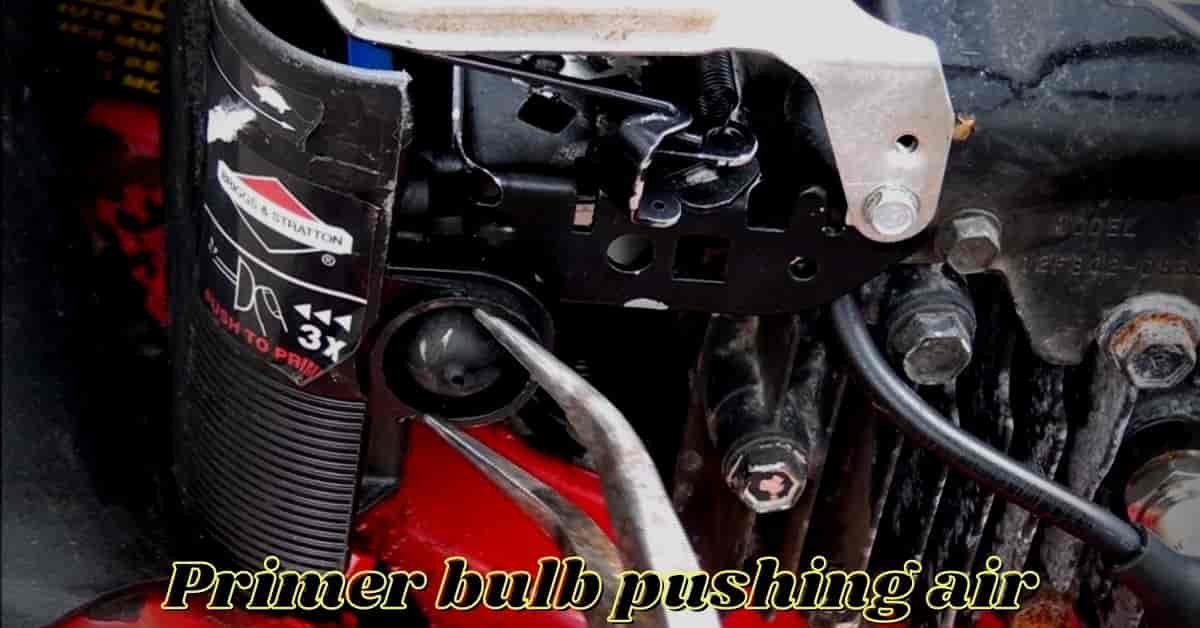Not understanding whether a primer bulb should push air or not can definitely cause enough stress. That’s why knowing the full process is important for a better understanding of the primer bulb.
So, is the primer bulb pushing air normal?
Yes, it’s definitely normal. When you press an air-filled primer bulb, it pushes the air inside the carburetor. This action causes a vacuum which forces the fuel to go inside the carburetor. So, the fueling process can’t begin without a primer bulb pushing air inside.
Well, that was only a short preview of the whole explanation. Read along if you want to know more information about the fueling process.
How To Tell If Primer Bulb Is Pushing Air Properly?

A primer bulb is built on fluid dynamics and follows Bernoulli’s principle. Simply put, if the primer bulb isn’t pushing the air properly, it’ll fail to create a flow of gasoline.
Knowing some carburetor parts will help you understand these phases better
Since the process is a bit lengthy, we’ve explained it in 3 phases. So, let’s take a look at if your primer bulb is pushing air properly or not-
Phase 1: Forcing the Inlet pipe to Push Fuel Inside the Carburetor
When the carburetor is fully idle, all of these parts are filled with air. With that in mind, let’s proceed.
When pressed, it pushes air inside the metering area via a suction tube. The rest of the air gets out of the system through the exit pipe.
So, a vacuum is created and it forces the inlet pipe to push fuel inside the fuel pump.
But it can’t do that right away. Because there’s still air inside the fuel pump which needs to be removed.
Now, the primer bulb has already started to return to its initial position. The suction tube now starts pushing air back to the bulb.
Also, the metering area is connected to the fuel pump via a tube. So, the fuel pump gets emptied in the process. It enables the inlet pipe to fill it up with fuel.
Phase 2: Fueling the Other Parts of the Carburetor
Now, the primer bulb has returned to the previous position. Also, it’s storing the remaining air sucked from the rest of the carburetor.
On the other hand, the fuel pump is now filled up with fuel. It has also filled up the main tube that’s separated from the metering area via a needle valve.
So, push the primer bulb again. Similarly, it pushes some air inside through the suction tube. But most of the air gets out via the exit pipe.
Again, the bulb starts going back to the initial position. It starts sucking the remaining air inside the metering area.
As a result, the diaphragm comes down and activates the needle valve. This grants open access to the metering area.
Now, the fuel starts going inside the metering area as air is being emptied. When it’s fully filled up, it enters the primer bulb via a suction tube.
Phase 3: Completing a Fuel Circulation
In this phase, the primer bulb has both air and fuel inside. When pressed for a third time, it will push the air and most of the fuel through the exit pipe.
On the contrary, some fuel will re-enter the metering area. Just like before, as the primer bulb starts reverting, it will open the needle valve again.
This results in more fuel going through the main tube via inlet pipe. Similarly, more fuel will also enter and fill up the primer bulb.
And that’s how the primer bulb circulates fuel around the carburetor.
Why Isn’t My Primer Bulb Reverting Back?
If you’ve followed us this far, you’ve seen how reverting affects fuel circulation. Sometimes, because of various reasons, a primer bulb may not revert properly.
Clogged Air Filter & Jammed Fuel Line
A clogged air filter will stop the air from going inside the primer bulb. On the other hand, a jammed fuel line won’t circulate enough fuel.
When these happen, the bulb might revert slowly. Sometimes, it may not revert back at all.
Deterioration
Depending on usage, a primer bulb can easily deteriorate over time. The bulb is always in contact with gasoline which softens the bulb.
Also, the heat from gasoline is responsible for deterioration. Another big reason behind the deterioration is the gunk piling up inside the bulb.
If you’re facing this issue, you should consider replacing a primer bulb.
Speaking of primer bulbs, here are our favorite picks-
Now, you can easily choose whichever you like and get it replaced right away!
Frequently Asked Questions
Question: Why is gas coming out of the primer bulb?
Answer: A clogged fuel filter or a bad needle valve can force too much gasoline inside the primer bulb. Also, leakage can cause the gasoline to go out.
Question: Do primer bulbs need to be filled with gas?
Answer: Not completely. The primer bulb should have gasoline for the most part. Gasoline dissipates heat which is harmful to the primer bulb.
Question: What happens if the fuel tank vent is clogged?
Answer: A clogged fuel tank vent will interrupt fuel circulation. The primer bulb may not revert back properly because of that reason.
Conclusion
Hopefully, this explains everything you wanted to know about the primer bulb pushing air.
If you have other inquiries regarding this issue, don’t hesitate to comment below. We’ll try our best to help you!
Finally, good luck!
- Are Phlox Deer Resistant? (Answer Revealed) - December 16, 2023
- 6 Ways to Bypass Primer Bulb on Weedeater (What to Do) - November 2, 2023
- Why Won’t My Peppers Turn Red [All Reasons & Solutions] - October 24, 2023
